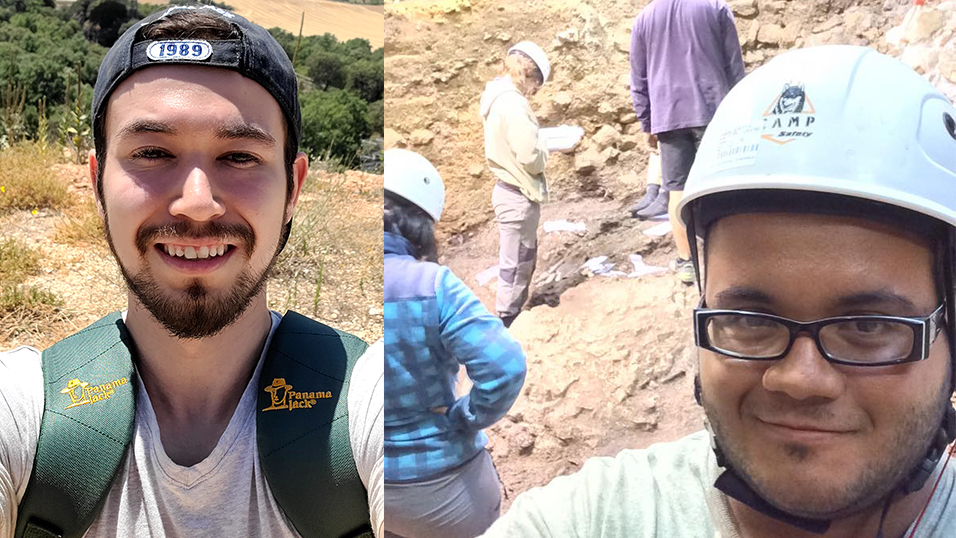From chins to ‘prairie madness’: Paleoanthropologists study what makes us human

What makes us human, and when did that start?
Is it the size of our brains, the structures in our throat that allow us to make speech, the tiny bones in our ear that capture that speech and relay its sound to our brain? Is it our tool-making thumbs? Our upright stance?
Other ancient hominins share most of these features in different configurations. But there’s one thing that Neandertals and other cousin species don’t have but we do.
“This thing right here: A chin,” explained Brian Keeling, a doctoral candidate in Binghamton University’s anthropology program. “It’s actually diagnostic.”
While Keeling focuses his research on the mandible (jawbone), fellow doctoral candidate Alex Velez focuses his on the temporal bone, which contains the structures responsible for hearing. The two paleoanthropologists have more in common than their focus on human origins: They both earned their master’s degrees at Binghamton and came to the University specifically to study under Professor Rolf Quam. In 2023, Keeling received a Fulbright award to conduct research in Spain.
Anthropology is an incredibly broad field with many potential paths for research. Their research, too, has taken them in fascinating directions: Keeling, a native of Illinois, spent several years studying a jawbone which is, historically, one of the earliest modern human fossils ever documented in Europe. Originally unearthed in 1887, researchers have considered it a Neandertal mandible, but had previously lacked modern methods to confirm this.
The jawbone turns out to be 45,000 to 65,000 years old — a prime time for Neandertals — but may have come from Homo sapiens, a modern human. In fact, it may be one of the earliest modern humans ever documented in Europe, he concluded. There’s only one problem: The jawbone lacks a chin, a defining feature of the modern human face. But did all Homo sapiens lineages have a well-defined chin?
“I personally suspect that there was a lineage of our species that once existed without a clearly defined chin, but more research needs to be done,” he said.
Velez’s interest in hearing has taken him in different directions, from differences in the cochlea of modern humans, Neandertals and an ancient, possibly proto-Neandertal hominin species found in Spain, to a phenomenon known as “prairie madness” found among American settlers of the Great Plains.
“There are different versions of the myth, but most of them agree that the soundscape of the Great Plains has something to do with it,” the New York City native said.
During his research, he combed historical records for episodes of aberrant human behavior on the prairie. He then took sound recordings from different places in the region and ran them through a spectral analysis to see what sound frequencies were most common.
“The result of that particular project was that the soundscape likely wasn’t the deciding factor for the development of, for instance, symptoms of anxiety, depression and violent outbursts that were associated with settlers at the time. But it was likely an influencing factor, and basically it was just a constellation of all of these different variables coming together to make life really difficult out there,” he explained.
Shifting perspectives
As undergraduates, Keeling and Velez didn’t imagine themselves studying bones from long-vanished human forebears and their cousins.
Velez initially considered a pre-med track and then public health administration. A course in biological anthropology inspired him and shifted his trajectory; he ended up triple-majoring in anthropology, biology and chemistry, he said. For his part, Keeling originally considered cultural anthropology, with a focus on the economic and sociopolitical disparities in Chicago. After meeting paleoanthropologists, he became fascinated with fossils and the long arc of human history.
“Homo sapiens existed 300,000 to 200,000 years ago. That’s thousands of generations that we still really don’t know about,” Keeling reflected. “It really shifts your perspective.”
Both graduate students recently published the results of their research in two peer-reviewed academic journals: Keeling in the Journal of Human Evolution and Velez in Historical Archaeology. These days, Keeling’s focus is on the human mandible, studying its biomechanics and the relationships between its form and function, and the evolution of the chin. Velez is currently studying the propagation of sound in the habitats of gibbons, a species of ape in southeast Asia known for communicating through song, potentially a type of proto-language.
“This is an exciting time to be doing research in human origins. There are new fossil discoveries each field season, and sophisticated technologies and methods to study the fossils are changing the field,” Quam said. “It is gratifying to see two of my students using these new research methods to carry out their projects. Training in these skills is critical to our graduate students going on to become professional anthropologists.”
Binghamton has provided opportunities for international research and collaboration, including trips to a World Heritage site in Spain. Fieldwork is a key component to paleoanthropology, and one of the essential skills it requires is teamwork, Velez and Keeling said.
Seen in that light, the camaraderie between professors and peers in the department not only makes the academic environment a welcoming place, but helps researchers develop the skills they need to collaborate with people from around the world.
“This is something that I like to tell new admits all the time: Your cohort will be your social anchor,” Velez said. “We develop these long-lasting friendships. Even though most of the friends I’ve made in this department are scattered halfway around the world, we still talk all the time and they’re still my social anchor.”
